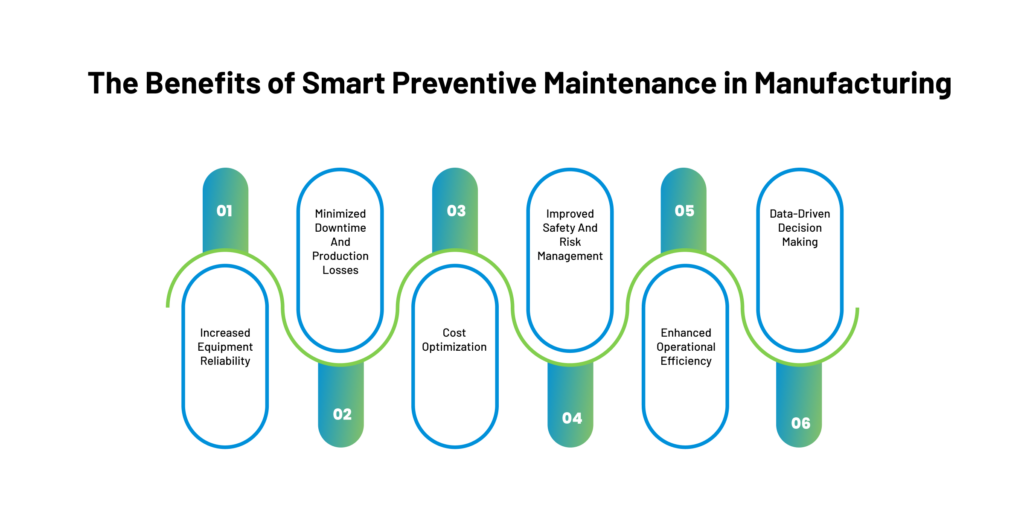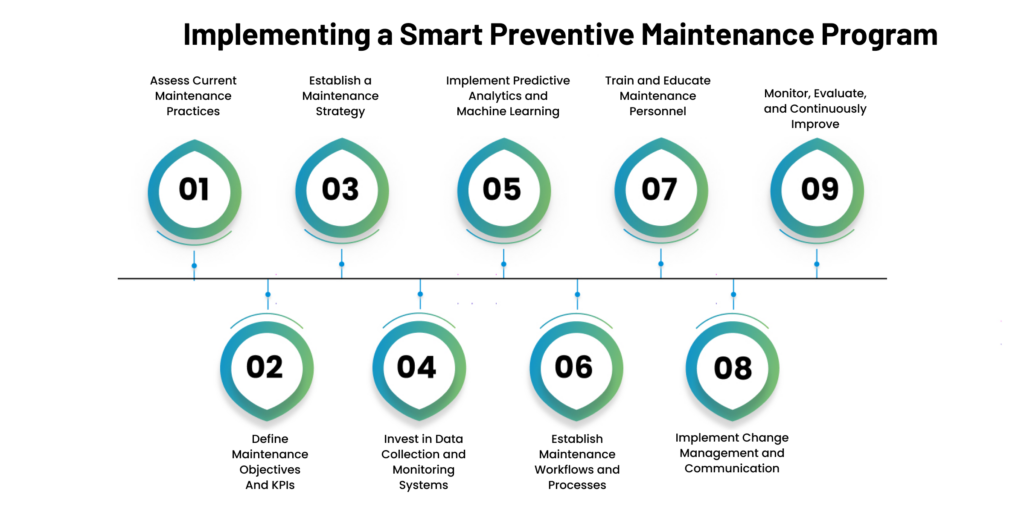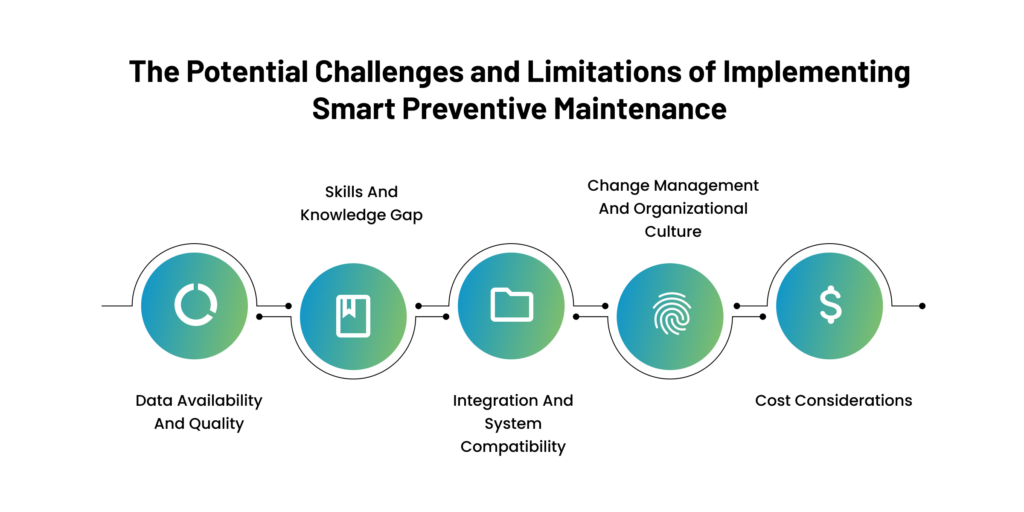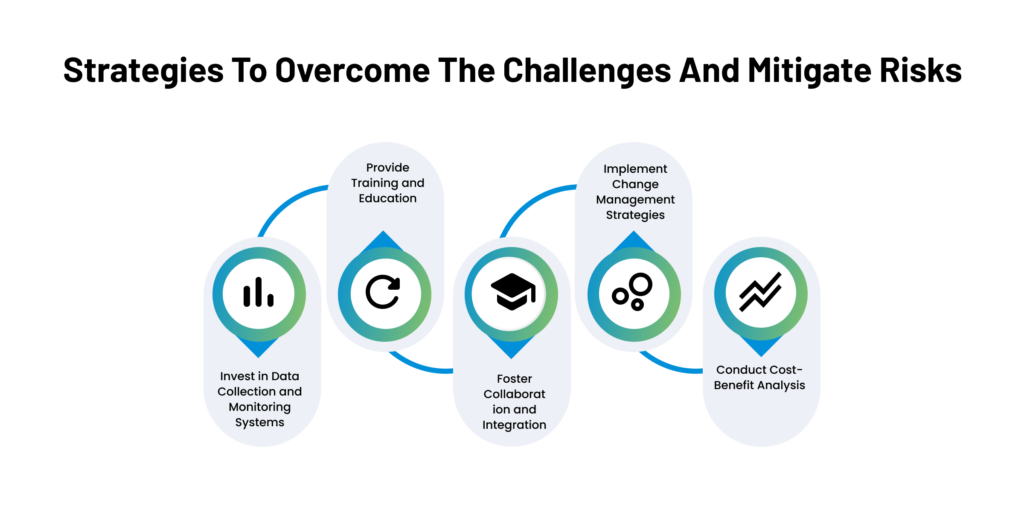As the wheels of progress continue to turn, the manufacturing industry finds itself at the forefront of transformative advancements in Industry 4.0 solutions. Preventive maintenance has garnered significant attention in this era of cutting-edge technologies and relentless innovation. Today, manufacturers would rely solely on reactive measures to address unplanned equipment failures and downtime. Instead, a paradigm shift is underway, championing the adoption of smart preventive maintenance strategies that revolutionize operations.
Downtime can translate into substantial losses in today’s manufacturing landscape, where every second counts. Hence, manufacturers increasingly realize the need to monitor, predict, and prevent potential equipment failures proactively. Smart preventive maintenance, powered by Industry 4.0 solutions, empowers them to stay one step ahead, harnessing the power of data, artificial intelligence, and advanced analytics to optimize performance, extend equipment lifecycles, and boost overall productivity.
This blog will delve into the transformative impact of smart preventive maintenance, enabled by Industry 4.0 solutions, on manufacturing operations. We will explore the fundamental principles behind this approach and highlight how it reshapes the industry. We will uncover the tools and technologies, such as Internet of Things (IoT) sensors, cloud computing, and predictive analytics, that manufacturers wield to optimize their processes and achieve operational excellence. Let’s get started.
Also, Read – From Automation to Digital Transformation: The Evolution of Industry 4.0
Understanding Preventive Maintenance (PM)
Preventive maintenance (PM) is a proactive approach to maintenance that aims to prevent equipment failures, optimize performance, and reduce unplanned downtime. It involves regularly scheduled inspections, adjustments, and machinery servicing to keep it in optimal condition. PM helps manufacturers avoid costly breakdowns, improve equipment reliability, and extend their lifespan by addressing potential issues before they escalate.
In manufacturing operations, where uptime and productivity are paramount, preventive maintenance holds immense significance. It allows manufacturers to shift from a reactive mindset, where equipment is repaired only after a failure occurs, to a proactive approach focused on preventing failures altogether. This shift minimizes disruptions and leads to substantial cost savings by eliminating emergency repairs and reducing overall maintenance expenses.
The Shift to Smart Preventive Maintenance: An Overview
Maintenance practices in the manufacturing industry have traditionally fallen into two categories: reactive and proactive maintenance. Reactive or “breakdown maintenance” involves addressing equipment failures after they occur, resulting in unplanned downtime and reactive repairs. On the other hand, proactive maintenance takes a preventive approach, conducting regular inspections and maintenance activities to identify and address potential issues before they escalate into failures.
Advancements in technology have played a pivotal role in driving the transition from reactive to proactive maintenance, leading to the emergence of smart preventive maintenance strategies. These strategies leverage data, connectivity, automation, and artificial intelligence (AI) to revolutionize maintenance practices in the manufacturing sector.
Reactive Maintenance:
Reactive maintenance is a reactive approach to maintenance that responds to equipment failures as they happen. In this approach, manufacturers only take action once a breakdown or malfunction occurs, often leading to unplanned downtime, reduced productivity, and increased costs. Reactive maintenance is typically characterized by a “fix it when it breaks” mentality, where repairs are made ad ad-hoc, often prioritizing immediate fixes over long-term equipment reliability.
Proactive Maintenance:
Proactive maintenance, in contrast, is a preventive approach that focuses on preventing failures and optimizing equipment performance. It involves scheduled inspections, routine maintenance tasks, and condition monitoring to detect and address potential issues before they result in breakdowns or performance degradation. Proactive maintenance extends equipment lifespan, minimizes unplanned downtime, and improves reliability and efficiency.
Also, Read – How Industry 4.0 Technologies are Changing Manufacturing
Advancements in Technology Enabling the Transition
The advent of advanced technologies has transformed maintenance practices, enabling the transition from reactive to proactive maintenance. Some critical technological advancements have played a pivotal role:
Internet of Things (IoT) and Connectivity: IoT devices and sensors can collect real-time data from equipment, providing valuable insights into their performance, condition, and potential maintenance needs. This connectivity allows for continuous monitoring, early detection of anomalies, and predictive analysis, enabling proactive maintenance interventions.
Data Analytics and Artificial Intelligence (AI): Advanced analytics and AI algorithms can process large volumes of data collected from equipment sensors and historical records. By analyzing patterns, trends, and correlations, AI can predict failures, identify maintenance patterns, and optimize maintenance schedules, shifting from reactive to proactive maintenance strategies.
Predictive Maintenance Software: Dedicated software platforms and algorithms are now available to monitor equipment health, analyze data, and provide predictive maintenance recommendations. These tools can generate automated alerts, create work orders, and optimize maintenance schedules based on real-time data, historical patterns, and machine learning algorithms.
Remote Monitoring and Diagnostics: Remote monitoring technologies enable maintenance teams to monitor equipment health and performance from a centralized location. With the ability to access real-time data and perform diagnostics remotely, maintenance personnel can identify issues, troubleshoot problems, and plan maintenance actions more efficiently.
Condition-Based Maintenance: Sensor technology and data analytics advances enable maintenance, where maintenance activities are triggered based on equipment’s actual condition and performance. Monitoring fundamental indicators such as temperature, vibration, and fluid levels allows maintenance to be scheduled when it is genuinely needed, optimizing resources and minimizing downtime.
Manufacturers can transition from reactive maintenance practices to innovative preventive maintenance strategies by harnessing these technological advancements. This shift empowers them to proactively manage their assets, optimize performance, reduce downtime, and achieve significant cost savings.
To understand better, let’s look at the benefits of implementing smart preventive maintenance strategies.
The Benefits of Smart Preventive Maintenance in Manufacturing
Implementing smart preventive maintenance strategies in manufacturing operations offers a range of significant benefits. These strategies leverage advanced technologies, data analytics, and proactive approaches to revolutionize maintenance practices. Here are some key benefits of implementing smart preventive maintenance:

Increased Equipment Reliability: By proactively identifying and addressing potential issues before they lead to failures, smart preventive maintenance enhances equipment reliability. Regular inspections, maintenance tasks, and condition monitoring enable manufacturers to detect early warning signs, mitigate risks, and prevent costly breakdowns. As a result, equipment downtime is minimized, and overall reliability is improved, leading to uninterrupted production and increased customer satisfaction.
Minimized Downtime and Production Losses: Unplanned downtime can harm manufacturing operations, resulting in missed deadlines, decreased productivity, and increased costs. Smart preventive maintenance helps minimize downtime by addressing maintenance needs before failures occur. Predictive analytics and real-time monitoring enable manufacturers to schedule maintenance during planned downtime, preventing unexpected equipment breakdowns and optimizing production schedules.
Cost Optimization: Smart preventive maintenance strategies offer cost optimization benefits in multiple ways. By identifying potential issues early on, manufacturers can take corrective actions at a lower cost, avoiding expensive emergency repairs. Additionally, scheduled maintenance activities help prevent significant equipment failures, reducing the need for costly component replacements and extensive repairs. Furthermore, by maximizing equipment reliability and lifespan, manufacturers can optimize their capital investments and avoid premature replacement.
Improved Safety and Risk Management: Well-maintained equipment is less likely to pose safety risks to operators and workers. Smart preventive maintenance ensures that safety-critical components are regularly inspected, calibrated, and maintained. This reduces the chances of accidents, injuries, and workplace hazards. Manufacturers can create a safer working environment and comply with stringent safety regulations by proactively managing risks through preventive maintenance.
Enhanced Operational Efficiency: Smart preventive maintenance optimizes operational efficiency by streamlining maintenance processes. Leveraging data analytics and AI, manufacturers can analyze equipment performance patterns, identify inefficiencies, and optimize maintenance schedules. Predictive maintenance enables the timely replacement of parts and components, reducing equipment downtime and enhancing overall equipment effectiveness (OEE). These efficiency gains result in improved productivity, reduced waste, and increased throughput.
Data-Driven Decision Making: Smart preventive maintenance relies on collecting and analyzing vast amounts of data from sensors, equipment logs, and historical records. By leveraging this data, manufacturers can gain valuable insights into equipment health, performance trends, and maintenance requirements. Data-driven decision-making allows for optimized resource allocation, better planning of maintenance activities, and continuous improvement of maintenance strategies over time.
In summary, implementing smart preventive maintenance strategies in manufacturing operations offers a transformative leap forward, unlocking many benefits that pave the way for sustainable success.
However, the advantages extend beyond operational aspects, fueling enhanced efficiency. Manufacturers can make informed decisions, optimize resource allocation, and continually improve their maintenance strategies by harnessing the power of data-driven insights and predictive analytics. This holistic approach to maintenance maximizes productivity and profitability and enhances competitiveness in the ever-evolving manufacturing landscape.
Implementing a Smart Preventive Maintenance Program
Implementing a smart preventive maintenance program in manufacturing requires careful planning and execution. Here are practical steps and considerations to guide the implementation process:

Assess Current Maintenance Practices – Evaluate existing maintenance processes and identify areas for improvement. Determine the effectiveness of current maintenance strategies, resource allocation, and documentation practices. This assessment serves as a baseline for designing the smart preventive maintenance program.
Define Maintenance Objectives and KPIs – Clearly define the objectives of the smart preventive maintenance program. Identify the desired outcomes, such as increased equipment reliability, reduced downtime, or improved safety. Establish relevant KPIs to measure the program’s effectiveness, such as mean time between failures (MTBF), overall equipment effectiveness (OEE), or maintenance cost per unit produced.
Establish a Maintenance Strategy – Develop a comprehensive maintenance strategy that aligns with the objectives and KPIs. Determine the appropriate mix of preventive, predictive, and condition-based maintenance approaches based on equipment criticality and performance history. Define the frequency and scope of maintenance tasks and inspections.
Invest in Data Collection and Monitoring Systems – Acquire the necessary tools and technologies to collect and monitor equipment data. This may include installing sensors, implementing IoT devices, or integrating existing data acquisition systems. Ensure that data collection is reliable, accurate, and aligned with the requirements of the maintenance strategy.
Implement Predictive Analytics and Machine Learning – Integrate predictive analytics and machine learning capabilities into the maintenance program. Leverage advanced algorithms and software platforms to analyze collected data, identify patterns, and predict maintenance needs. Explore machine learning models that continuously improve predictions and adapt to changing equipment conditions.
Establish Maintenance Workflows and Processes – Define clear workflows and processes for maintenance activities. Document step-by-step procedures for inspections, maintenance tasks, data analysis, and reporting. Establish guidelines for work order management, prioritization, and escalation processes. Ensure that maintenance tasks are appropriately scheduled, assigned, and tracked.
Train and Educate Maintenance Personnel – Provide comprehensive training and education to maintenance personnel on the principles and practices of smart preventive maintenance. Familiarize them with new technologies, tools, and data analysis techniques. Equip them with the skills to interpret data, monitor conditions, and effectively leverage predictive insights.
Implement Change Management and Communication – Address the cultural and organizational changes that come with implementing a smart preventive maintenance program. Communicate the benefits, objectives, and expectations to all stakeholders, including management, maintenance teams, and production staff. Encourage collaboration, involvement, and employee feedback to ensure a smooth transition.
Monitor, Evaluate, and Continuously Improve – Regularly monitor the performance of the smart preventive maintenance program against established KPIs. Assess the effectiveness of maintenance activities, data analysis, and decision-making processes. Identify areas for improvement and implement refinements to optimize the program. Encourage a culture of continuous improvement and learning within the maintenance team.
Implementing a smart preventive maintenance program based on these practical steps and considerations enables manufacturers to achieve improved equipment reliability, reduced downtime, optimized maintenance practices, and enhance overall operational efficiency. However, it is essential to recognize the challenges and limitations inherent in preventive maintenance. And what are these challenges and limitations? It’s time to explore.
The Potential Challenges and Limitations of Implementing Smart Preventive Maintenance
Implementing smart preventive maintenance in manufacturing operations comes with its own set of challenges. It’s essential to anticipate and address these potential obstacles to ensure a successful implementation. Some common challenges manufacturers may encounter are –

Data Availability and Quality – Obtaining access to accurate and reliable equipment data can be challenging, especially if the necessary sensors and monitoring systems are not in place or if existing data needs to be completed or is of poor quality. More data is needed to maintain the effectiveness of predictive analytics and decision-making processes.
Skills and Knowledge Gap – The successful implementation of smart preventive maintenance requires specialized skills and knowledge in data analysis, predictive analytics, and maintenance technologies. Ensuring maintenance personnel possess the necessary expertise to leverage new technologies effectively may take time and effort.
Integration and System Compatibility – Integrating smart preventive maintenance systems with existing enterprise systems, such as enterprise asset management (EAM) or computerized maintenance management systems (CMMS), can be complex. Compatibility issues, data synchronization, and establishing seamless communication between systems may pose challenges during the integration process.
Change Management and Organizational Culture – Shifting from reactive to proactive maintenance requires a cultural shift within the organization. Resistance to change and lack of employee buy-in can hinder the successful implementation of smart preventive maintenance. Overcoming resistance and fostering a proactive maintenance culture may require effective change management strategies and clear communication.
Cost Considerations – Implementing smart preventive maintenance systems and technologies may involve significant upfront costs, including equipment, sensors, software platforms, and training investments. Cost considerations can be a barrier, especially for smaller manufacturing organizations with limited budgets and resources.
Strategies to Overcome the Challenges and Mitigate Risks
To address the potential challenges and mitigate risks associated with implementing smart preventive maintenance, manufacturers can employ the following strategies:

Invest in Data Collection and Monitoring Systems – Ensure reliable and accurate data availability by investing in appropriate sensors, monitoring systems, and data validation processes. Prioritize data quality and establish data collection, storage, and analysis protocols.
Provide Training and Education – Equip maintenance personnel with the necessary skills and knowledge through training and education programs. Offer opportunities for upskilling in data analysis, predictive maintenance techniques, and technology usage.
Foster Collaboration and Integration – Work closely with IT teams and system vendors to ensure seamless integration between smart preventive maintenance systems and existing enterprise systems. Define clear data interfaces, establish communication protocols, and conduct thorough testing and validation.
Implement Change Management Strategies – Engage employees at all levels, communicate the benefits of smart preventive maintenance, and address concerns and resistance to change. Involve maintenance personnel in the decision-making process, provide training and support, and promote a culture of continuous improvement.
Conduct Cost-Benefit Analysis – Conduct a comprehensive cost-benefit analysis to demonstrate the long-term savings and return on investment associated with smart preventive maintenance. Explore options for phased implementation or pilot projects to manage costs and demonstrate the program’s value before full-scale deployment.
By implementing these strategies, manufacturers can overcome the challenges of implementing smart preventive maintenance, mitigate risks, and successfully transition to a proactive maintenance approach. This, in turn, enables them to unlock the full potential of preventive maintenance in improving equipment reliability, reducing downtime, and enhancing operational efficiency.
Also, Read – Industry-Specific Challenges in Manufacturing: How to Overcome Them
Conclusion:
The shift from reactive to proactive maintenance revolutionizes manufacturing operations, and smart preventive maintenance is at the forefront of this transformative change. By embracing advanced technologies, data-driven insights, and proactive strategies, manufacturers can optimize equipment reliability, minimize downtime, and enhance operational efficiency. Implementing smart preventive maintenance programs enables manufacturers to stay ahead of potential failures, mitigate risks, and achieve significant cost savings.
As we look toward the future, emerging trends and technologies continue to shape the landscape of preventive maintenance in manufacturing. Industry 4.0 solutions, focusing on connectivity, automation, and data analytics, are driving the evolution of maintenance practices. Manufacturing technology companies are pivotal in developing innovative tools and software platforms that enable predictive analytics, remote diagnostics, and real-time monitoring.
The future of preventive maintenance holds great promise, with advancements such as artificial intelligence, machine learning, and predictive analytics driving continuous improvement. These technologies enable more accurate prediction of maintenance needs, optimization of maintenance schedules, and intelligent decision-making. Manufacturers can leverage these emerging trends and technologies to enhance their preventive maintenance practices further, leading to improved productivity, profitability, and competitiveness.
In this dynamic landscape, manufacturers must stay informed about the latest developments and embrace the opportunities presented by emerging technologies. By staying proactive and continuously evolving their preventive maintenance strategies, manufacturers can navigate the changing demands of the industry and harness the full potential of smart preventive maintenance to transform their operations.
The journey from reactive to proactive maintenance is transformative, and smart preventive maintenance is the catalyst that drives this transformation. By leveraging data, embracing emerging technologies, and adopting proactive strategies, manufacturers can elevate their operations to new heights of efficiency and reliability. The future of preventive maintenance in manufacturing is bright, and those who embrace it will thrive in an increasingly competitive landscape.




